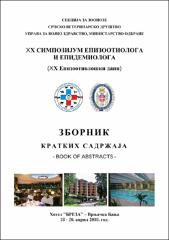Pojava terenskog soja virusa Gumboro bolesti kod vakcinisanih koka nosilja u odgoju

View/
Date
2018Author
Knežević, Slobodan
Pajić, Marko
Samojlović, Milena
Božić (Đurđević), Biljana
Todorović, Dalibor
Vidaković, Suzana
Babić, Jelena
Lupulović, Diana
Petrović, Tamaš
Polaček, Vladimir
Metadata
Show full item recordAbstract
An outbreak of infectious bursal disease (Gumboro disease) occurred at the end of 2017 on a layer chickens farm in South Bačka district, Serbia. The rearing house on the poultry farm consists of two separated premises, marked as A and B. Both premises were inhabited with Lohman Brown hybrid chickens from the same parent flock. Premise A was inhabited seven days before premise B, each with full capacity of 32 000 layer chickens. On the seventh day of the age of chickens blood samples were taken and a serological test (ELISA) was performed in order to detect the level of maternal antibodies. After analysing antibody titer values, using Deventer formula the optimal time of vaccination was determined. Accordingly, vaccination with vaccine containing intermediate strain of Gumboro disease virus was recommended on the 18th and 29th day of the age of chickens. The farmer applied live vaccine containing virus strain 228E on the 18th day of age and live vaccine containing virus strain D78 on the 29th day of age. Both vaccines were administered per os, through the drinking water. Occurrence of death of chickens in premise B started on the 38th day of age and continued to the 45th day, while there were no deaths in premise A. The mortality rate was 3.75%. Except for mass deaths the chickens were exhausted, prostrated, dehydrated, they suffered from watery diarrhea and their feathers were ruffled. Post-mortem examination revealed haemorrhagic and swollen bursas filled with straw coloured fluid, including haemorrhages in breast and leg muscles. Samples of bursa were taken for further RT-PCR examination, which confirmed the suspicion of Gumboro disease. After a thorough investigation of the whole management at the farm and comparing it on both premises, A and B, it was concluded that the main cause, which led to vaccination failures, was unequal distribution of chickens in individual cages in premise B. In some cages there were 50% more chickens than recommended according to breeding technology. Consequently, not all chickens were able to consume necessary dose of vaccine, which led to occurrence of Gumboro disease.
